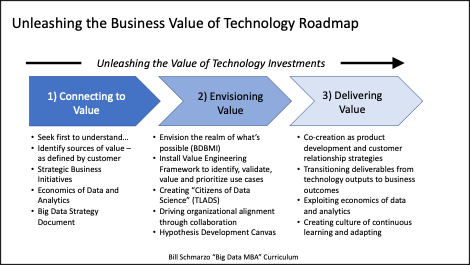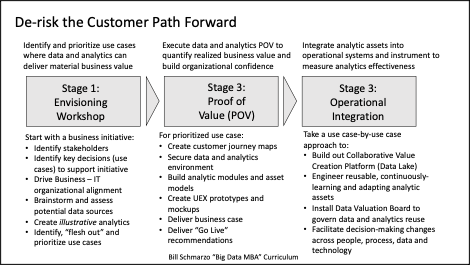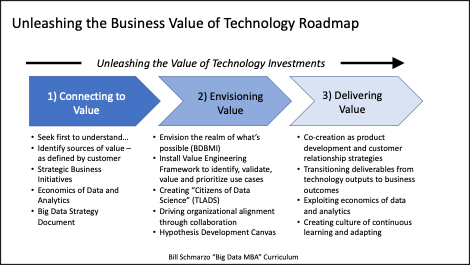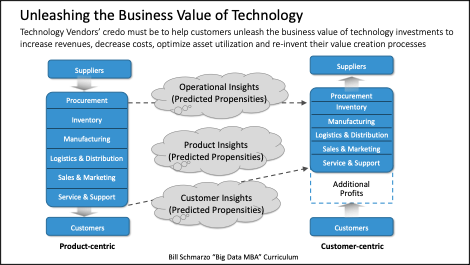
We are now ready to wrap up the four-part series on how technology vendors especially data and analytic technology vendors (and what technology vendors are not involved in data and analytics nowadays) can help their customers to unleash the business value of their technology investments.
I wrote this four-part series because in my journeys these past few months, both technology customers and technology vendors bemoaned their frustrations with deriving business value from their technology investments. And senior IT leadership in particular were coming under increased scrutiny about delivering on the promise of these technology investments.
In Part 1, I introduced the 3 stages of unleashing the business value roadmap: 1) Connecting to Value, 2) Envisioning Value and 3) Delivering Value (see Figure 1).

Figure 1: Unleashing the Value of Technology Roadmap
In Part 2, I provided some techniques that enable technology vendors to connect to value, but that is value as defined by the customers business initiatives, not value as defined by the technology vendors product or services capabilities. I introduced two fundamental techniques for vendors who want to connect with their customers sources of value creation:
- Step 1: Understanding how your customers make money. This requires investing the time upfront to research a customers key business initiatives and their supporting business and operational use cases.
- Step 2: Triaging Your customers business initiatives. I introduced the Big Data Strategy Document for helping technology vendors understand where and how data and analytics might support their customers key business initiatives.
In Part 3, I reviewed some techniques to help customers envision the realm of whats possible with respect to how data and analytics to derive and drive new sources of customer, product, and operational value.
Now in Part 4, its time to bring home the bacon!
De-risk the Path Forward
Part 4 is where the rubber (and vendor commitment) hits the road. Part 4 provides an opportunity for technology vendors to create a co-creation relationship with their customers to help them unleash the value of their technology investments.
The 3-stage customer engagement model depicted in Figure 2 de-risks the customers decision to move forward by putting a large majority of the onus of success on the technology vendor. This approach provides the technology vendor with the opportunity to prove that they can deliver on the business potential of their customers technology investments (see Figure 2).

Figure 2: De-risk the Customer Path Forward
Stage 1: Envisioning Workshop builds off our earlier work in connecting to value and envisioning value to assure the customer that the solution and outcomes being proposed are relevant and meaningful vis-Ã -vis their business objectives. Stage 1 is typically a low-cost, 2 to 3-week collaborative engagement with the key business stakeholders to identify, validate, value, and prioritize the use cases where data and analytics can deliver material business value.
Stage 2: Proof of Value (POV), or sometimes called the Minimal Viable Product (MVP), focuses on proving the business value of the prioritized use case identified in Stage 1. This 4 to 6-month co-creation engagement requires close collaboration between the vendor and the customer to quantify the realized business value while build confidence in the vendors ability to deliver said solution. While many different technology tools will likely be used in Stage 2, the primary focus of Stage 2 is to prove the vendors ability to deliver quantifiable, relevant, and actionable business and operational outcomes.
Stage 3 builds upon the business and operational learnings from Stage 1 and reuses the technology assets co-created in Stage 2 to integrate the technology assets into the customers operational and management systems. Having proven in Stage 2 that the vendor can deliver on the business potential, scaling (and governance becomes a key focus in Stage 3 as the underlying technology architecture and infrastructure facilitates the on-going delivery of business outcomes against the different customer use cases.
Establishing the Data Monetization Governance Board
Success breeds success, and after the successful execution of stage 3, more and more business units will also want the opportunity to unleash the business value of their technology investments to deliver meaningful, relevant and actionable business and operational outcomes. To properly manage the sudden demand and to avoid the data silos and orphaned analytics that doom the long-term economic value of data and analytics (yea, I wrote the book The Economics of Data, Analytics, and Digital Transformation that talks all about that), the customer will need help in establishing a Data Monetization Governance Board.
The Data Monetization Governance Board champions and enforces data and analytic monetization best practices across the organization. The Data Monetization Board has both the responsibility and the authority (the carrot and the stick) to enforce the sharing, reuse and continuous refinement of the organization’s data and analytic assets. Otherwise data monetization will continue to be a haphazard effort with disappointing results.
As I discuss in the blog Digital Transformation Requires Redefining Role of Data Governance the Data Monetization Governance Board must:
- Evangelize a compelling vision to the business executives regarding the economic potential of data and analytic assets to power an organizations digital transformation.
- Educate senior executives, business stakeholders and strategic customers on how to Think Like a Data Scientist in identifying and envisioning where and how data and analytics can deliver quantifiable and relevant business value.
- Apply Design Thinking and Value Engineering concepts in collaborating with business stakeholders to identify, validate, value and prioritize the organizations high-value use cases that will drive the organizations data and analytics development roadmap.
- Charter the Data Science team to engineer reusable, continuously-learning and adapting analytic assets that support the organizations high priority use cases.
- Develop an analytics culture that synergizes the AI / ML model-to-human collaboration that empowers teams at the point of customer engagement and operational execution.
If data is the new oil the catalyst for the economic growth in the 21st century then the Data Monetization Governance Board may very well be the most important structure in the modern organization.
Unleashing the Business Value of Technology End Goal
Hopefully this 4-blog series can help technology vendors unleash the business value of their customers technology investments. This outcomes-driven process starts by (1) connecting with the customers sources of value creation, then (2) help the customer to envision the possibilities in leveraging data and analytics to drive business outcomes. And finally, (3) provide an iterative delivery model to de-risk the customers path forward (see Figure 3).

Figure 3: Unleashing the Business Value of Technology Roadmap
In the end, if the technology vendor cant help customers unleash the business value of their technology investments, then they are in the wrong business (see Figure 4).

Figure 4: Unleashing the Business Value of Technology
It should be like printing money¦for your customers¦
